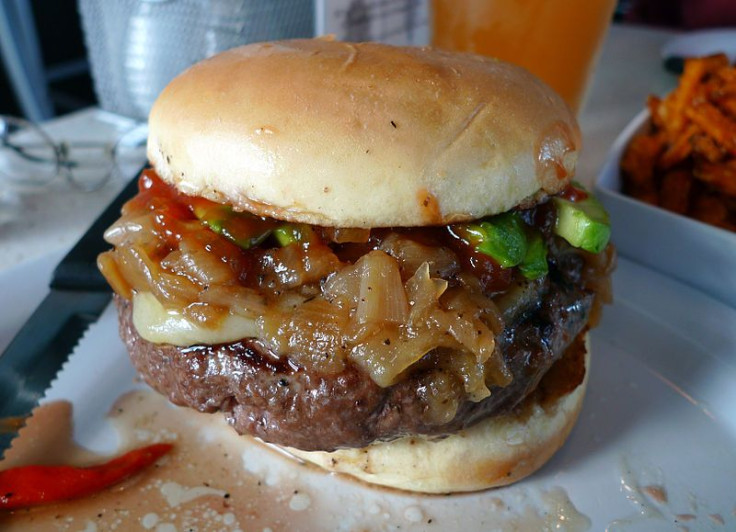World's First Test-Tube Burger Coming To London Next Week: In Vitro Meat Cost $380,000 To Make

In a publicity stunt that may feel vaguely reminiscent to some, the first "test-tube burger" will be served in London next week. The 5 oz. of meat will not come from a slaughtered animal but instead has been grown in a laboratory by Dr. Mark Post of the Netherlands for nine weeks at a cost variously quoted at figures ranging from $325,000 to $385,000. (The money behind this designer burger was provided by the Dutch government as well as a wealthy donor who prefers anonymity.) Originally projected to be served a couple of years ago — The Guardian announced a similar event for last fall but reportedly Post was not satisfied with the texture and taste at that time — this burger will be made from 20,000 strips of lab-grown meat tissue combined with lab-grown animal fat.
Although the lucky person who will eat this burger remains unknown, the scientist who created it has already tested the meat. According to the New York Times, Post believes that the meat tissue he has engineered "tastes reasonably good" and only salt and pepper will be added to it for the event in London. Meanwhile, his work continues until the scheduled event.
Man And Manufacture
A medical doctor with additional Ph.D. training in Pulmonary Pharmacology, Post has worked as an assistant professor in Medicine at Harvard Medical School. In 2002, he returned to the Netherlands as a professor of Vascular Physiology at the Maastricht University and professor of Angiogenesis in Tissue Engineering at the Technical University Eindhoven. Working with a team of six on this particular project, Post first extracts muscle stem cells from a cow's neck through a biopsy procedure and carefully cultivates them in petri dishes. There, they bathe in a medium containing cow fetus serum and nutrients that help them grow into proper strips of muscle. Post told the New York Times that at this point, they look 'something like a short pink rice noodle.' Next, he 'exercises' these strips as one might real muscle, stretching them across a fabricated scaffold and then flexing and contracting the strips while routinely shocking them with an electric current to promote growth. When they have attained the necessary bulk, the strips of muscle will be minced along with laboratory-fabricated fat and formed into a hamburger, ready for the grill.
Synthesizing meat in this way, Post told The Guardian, means scientists could produce meat with a particular texture or level of fatty acids. In short, they could design the meat as consumer tastes demand. And although the process of making a burger in a scientific laboratory may seem unsavory to many, in all likelihood the process of 'making' a real hamburger, with the attendant (unseen) slaughter of a cow, would be equally so, albeit in a very different way.
To commercially produce meat in this way, though, remains a good 10 to 20 years away, according to Post as well as other scientists in the field.
Challenges
Just as commercial supply of real beef requires industrial conditions, so too would commercial manufacture of synthetic meat. According to Focus Science And Technology, large bioreactors would replace the petri dishes and the early muscle cells would be grown in massive and "sterile conditions to prevent contamination from bacteria and disease." The technical challenges involved in exercising the strips as is currently done, though, appear unfeasible. Although growing meat might require less land, the real costs in terms of energy and resources have yet to be calculated.
Currently, though, the cost of meat is unsustainable according to many. In the U.S. alone, nine billion animals are prepared and killed for food each year. The UN Food and Agricultural Organization estimates that livestock contributes almost 20 percent of global greenhouse emissions while cattle consume one-tenth of the world's fresh water supplies. Interestingly, though, the U.S. Department of Agriculture shows total U.S. beef consumption as having leveled off, at least for now. According to its figures ranging from 2002 to 2011, consumption of beef peaked in the years 2006 and 2007 at 28.1 billion lbs., up from a low of 27.0 billion lbs. recorded for the year 2003. In 2011, though, 25.6 billion lbs. of meat were consumed.
Some scientists predict consumption to remain steady in industrial nations with growing demand in developing nations; this, though, is not a view shared by all. In any event, the World Health Organization links the consumption of meat, milk, and eggs with rising incomes and increasing urbanization. Meanwhile, world population figures doubled between 1959 and 1999, an increase to six billion people in just 40 years and currently the U.S. Census Bureau projects world population will grow to nine billion by 2044. Based on projections of increasing population and concurrent demand, annual meat production may increase from 218 million tons in 1997-1999 to 376 million tons by 2030.
But will it be televised?
The purpose of publicly cooking a burger and eating it in an 'undisclosed London location' is purely for the sake of gaining attention, Post frankly concedes. Yet, to him, it is a necessary 'proof of concept.' "Meat demand is going to double in the next 40 years and right now we are using 70 percent of all our agricultural capacity to grow meat through livestock," Post told The Guardian. With his hard work as well as this publicity stunt, he clearly hopes to spur the food industry toward more sustainable, if more revolutionary, practices.
Source: Global and regional food consumption patterns and trends. World Health Organization Press. 2013.



























